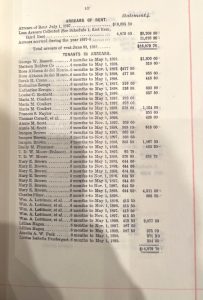The Columbia Board of Trustees minutes offers a trove of information about the school’s financial and institutional history— and its long involvement in New York City real estate. Elisha Baker examined the Trustees records to suss how and why Columbia moved uptown to Morningside Heights: how did they decide what real estate to purchase? Whom did they buy from? And, what was Columbia’s role as a landlord and renter? Here, Baker shares some of his finds from the archives:
What brings you to Columbia’s Rare Book & Manuscript Library?
For my particular line of inquiry into Columbia and Slavery, I am looking at Columbia’s real estate ventures vis-à-vis their midtown campus (also known as the Upper Estate), which the school was located in from 1857-1897, when they moved to Morningside Heights. A huge part of that research has been looking for the names of who rented property from Columbia before, during, and after that 40 year period in order to try and trace their money and see if it has any slavery-related roots. I have been visiting the RBML because of their extensive collection of records from the Columbia Board of Trustees, who discuss plans for the university’s properties in the Minutes as well as treasurers’ reports on Columbia’s different sources of income.
How long have you been using RBML materials (for this and/or previous research)?
I’ve been using RBML materials for just over a month now.
What have you found? Did you come here knowing this material was here?
I have found what I was expecting – a bunch of names of buyers and renters of the particular property I am looking into, and dollar amounts of rent collected in any particular year. My next steps are to look more closely at who those people were.
What have you found that’s surprised or perplexed you?
Not surprising as much as it is perplexing, but I was fascinated to see that the board of trustees don’t keep such great records of who they rent to on an annual basis, other than those who haven’t paid. It makes me wonder more about what the system was for renting property – I know from my research that the finance committee was in charge of dealing with that, but I want to find out more about their process.
What advice do you have for other researchers or students interested in using RBML’s special collections?
I’ll just pass on the advice that my amazing professors Stephanie McCurry and Josh Morrison gave me, which is to take pictures and scans. It takes a long time to get through these materials, even when you’re just skimming through. And it is difficult to get an appointment at the RBML, so you can’t count on being able to just go right back and pull out the same archival collection. Scan into PDFs and label everything (!!) so that you can go back and close read without the time constraint of your RBML appointment.
